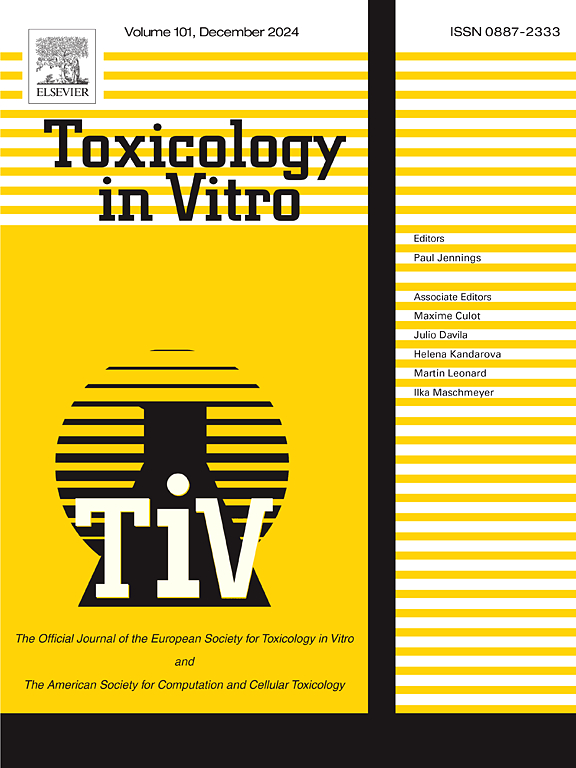Effects of Penthorum chinense pursh and gallic acid on embryonic and cardiac development in zebrafish (Danio rerio)
IF 2.6
3区 医学
Q3 TOXICOLOGY
引用次数: 0
Abstract
Penthorum chinense Pursh (P. chinense), known for its anti-inflammatory and antioxidant properties, is valued for its low toxicity in animal and human models. However, concerns have arisen regarding the developmental effects of its bioactive components. This study investigates the acute toxicity of P. chinense extract and gallic acid on zebrafish embryos. The calculated LC50 values were 237.0 mg/L for P. chinense extract and 328.4 mg/L for gallic acid, demonstrating a dose-response relationship with increasing mortality rates. Developmental assessments revealed significant morphological abnormalities, including heart defects, swim bladder and tail malformations, particularly at higher concentrations. Body length and eye diameter showed a hormetic dose-response to P. chinense extract, with increased growth at lower concentrations but a decrease at higher doses. Cardiac evaluations revealed altered heart rates, initially increasing and then decreasing at elevated concentrations. qRT-PCR analyses confirmed modulation of several heart-related genes, highlighting the differential impacts on cardiac development. These findings underscore the need to carefully assess the potential risks of P. chinense extract and gallic acid exposure in aquatic organisms.
五倍子提取物和没食子酸对斑马鱼胚胎和心脏发育的影响
中国紫草(P. chinense)以其抗炎和抗氧化特性而闻名,因其在动物和人体模型中的低毒性而受到重视。然而,人们对其生物活性成分对发育的影响感到担忧。本研究探讨了五倍子提取物和没食子酸对斑马鱼胚胎的急性毒性。五倍子提取物的LC50值为237.0 mg/L,没食子酸的LC50值为328.4 mg/L,呈剂量-效应关系。发育评估显示了显著的形态学异常,包括心脏缺陷、鱼鳔和尾部畸形,特别是在高浓度下。体长和眼直径对紫杉树提取物有显著的剂量效应,浓度越低,生长越快,剂量越大,生长越慢。心脏评估显示心率改变,浓度升高时先升高后降低。qRT-PCR分析证实了几个心脏相关基因的调节,突出了对心脏发育的不同影响。这些发现强调了仔细评估水生物暴露于五倍子提取物和没食子酸的潜在风险的必要性。
本文章由计算机程序翻译,如有差异,请以英文原文为准。
求助全文
约1分钟内获得全文
求助全文
来源期刊

Toxicology in Vitro
医学-毒理学
CiteScore
6.50
自引率
3.10%
发文量
181
审稿时长
65 days
期刊介绍:
Toxicology in Vitro publishes original research papers and reviews on the application and use of in vitro systems for assessing or predicting the toxic effects of chemicals and elucidating their mechanisms of action. These in vitro techniques include utilizing cell or tissue cultures, isolated cells, tissue slices, subcellular fractions, transgenic cell cultures, and cells from transgenic organisms, as well as in silico modelling. The Journal will focus on investigations that involve the development and validation of new in vitro methods, e.g. for prediction of toxic effects based on traditional and in silico modelling; on the use of methods in high-throughput toxicology and pharmacology; elucidation of mechanisms of toxic action; the application of genomics, transcriptomics and proteomics in toxicology, as well as on comparative studies that characterise the relationship between in vitro and in vivo findings. The Journal strongly encourages the submission of manuscripts that focus on the development of in vitro methods, their practical applications and regulatory use (e.g. in the areas of food components cosmetics, pharmaceuticals, pesticides, and industrial chemicals). Toxicology in Vitro discourages papers that record reporting on toxicological effects from materials, such as plant extracts or herbal medicines, that have not been chemically characterized.
 求助内容:
求助内容: 应助结果提醒方式:
应助结果提醒方式:


